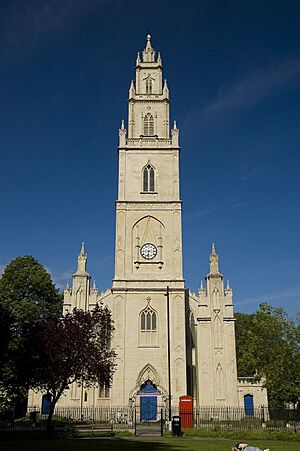St Pauls, Bristol facts for kids
Quick facts for kids St Paul's |
|
|---|---|
| OS grid reference | ST596742 |
| Unitary authority | |
| Ceremonial county | |
| Region | |
| Country | England |
| Sovereign state | United Kingdom |
| Post town | BRISTOL |
| Postcode district | BS2 |
| Dialling code | 0117 |
| Police | Avon and Somerset |
| Fire | Avon |
| Ambulance | Great Western |
| EU Parliament | South West England |
| UK Parliament |
|
St Pauls (also known as St Paul's) is a lively area in Bristol, England. It's located just northeast of the city centre and west of the M32. Imagine it as a neighbourhood close to the heart of the city.
This area is surrounded by several main roads: the A38 (Stokes Croft), the B4051 (Ashley Road), the A4032 (Newfoundland Way), and the A4044 (Newfoundland Street). For a long time, the River Frome was its eastern border before the A4032 road was built. St Pauls was first planned and built in the early 1700s, making it one of Bristol's first neighbourhoods outside the main city.
Contents
A Look at St Pauls' Past
Growth and Change
In the 1870s, a large factory called Brooks Dye Works opened near St Pauls. This factory created many jobs for people living nearby. Because of this, many terraced houses (rows of houses joined together) were built.
At the same time, many people moved to Bristol, both from other countries and from different parts of Britain. This led to St Pauls becoming a very busy and crowded neighbourhood by the Victorian era.
After World War II
St Pauls was damaged by bombs during World War II. After the war, new homes and money for rebuilding were mostly spent on other areas like Hartcliffe and Southmead. This meant St Pauls didn't get as much help, and the area started to decline.
In the 1950s, many people moved to Bristol from places like Jamaica and Ireland. A lot of these new residents chose to settle in St Pauls, adding to its diverse community.
The Bristol Bus Boycott
In 1963, St Pauls became famous for an important event called the Bristol Bus Boycott. People from the British African-Caribbean community organized this protest. They were upset because the Bristol Omnibus Company, which ran the city's buses, refused to hire non-white workers as bus drivers or conductors. This was known as a "colour bar."
The protest lasted for sixty days. Because of their strong actions, the company changed its policy in August 1963. This boycott was a big step and helped lead to the Race Relations Act 1968, a law that made it illegal to discriminate against people because of their race.
Community Spirit and Challenges
On April 2, 1980, there was a difficult time in St Pauls' history. A riot happened after police raided a place called the Black and White Café. People often blamed the riot on race, but both white and black young people from Irish, Jamaican, and English backgrounds were involved.
Many people believe the problems were more about poverty and feeling like they were treated unfairly by society. The Black and White Café closed in 2005 and was later taken down to make way for new houses. Today, St Pauls is going through positive changes with projects like the St. Pauls Unlimited scheme, which aims to improve the area.
Community Life in St Pauls
St Pauls is known for its large African-Caribbean population. Even though the area has faced challenges, it has a very strong community spirit. This is especially clear during the St Pauls Carnival.
St Pauls Carnival
The St Pauls Carnival is a huge, colourful event, similar to the Notting Hill Carnival in London. It has been held almost every year since 1967. By 2006, about 40,000 people came to enjoy the carnival each year! It features a lively parade with local primary schools and community groups taking part. It's a wonderful celebration of culture and community.
 |
Kingsdown | Montpelier | St Agnes |  |
| Stokes Croft | Easton | |||
| Broadmead | Broadmead | St Jude's |
Green Spaces and Parks
St Pauls has several nice parks and green areas where people can relax and play. The main parks are St Agnes Park and St Paul's Park. There are also Portland and Brunswick squares, which offer more green space. Other smaller green spots include Grosvenor Road Triangle and Dalrymple Road Park. You can also reach Riverside Park, which is next to the Frome River, by using a footbridge over the A4032 road.
St Pauls' Architecture
Many buildings in St Pauls were built during the Georgian era (the 1700s and early 1800s). Two great examples of this style are Portland Square and St Paul's Church. Both were designed by Daniel Hague.
Work on St Paul's Church began in 1789 and finished in 1794. A famous Victorian architect named Edward William Godwin even lived at Portland Square. In 2005, St Paul's Church was changed into its current use as the home of 'Circomedia', a special school for circus arts.
Future Plans for St Pauls
In May 2007, plans were announced to build new homes, offices, and businesses in the St Pauls area. These plans could include a very tall, 40-storey tower (about 600 feet high) next to the M32 motorway. This tower would be a new landmark for people entering the city, similar in shape to the "gherkin" tower in London.



